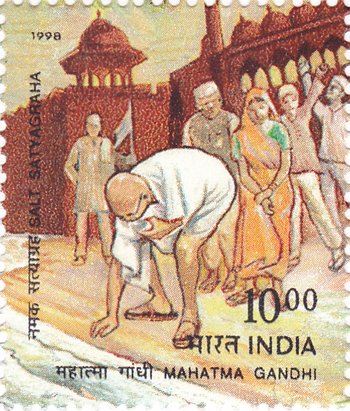Mahatma Gandhi – Salt Satyagraha (50th Death Anniversary)

Technical Data
| Stamp Set | Death Centenary Golden Jubliees Mahatma Gandhi Memorial |
|---|---|
| Date of Issue | January 30, 1998 |
| Denomination | Rs. 10 |
| Quantity | 700,000 |
| Perforation | comb 14 |
| Printer | Security Printing Press, Nashik |
| Watermark | No Watermark |
| Colors | Multicolor |
| Catalog Codes |
Michel IN 1613 Stamp Number IN 1673 Yvert et Tellier IN 1380 Yvert et Tellier IN 1777 |
| Themes | Anniversaries and Jubilees | Famous people | Human Rights | Independency Activists | Lawyers-Advocates | Men | Optical Instruments | Teachers |
Table of Contents
Commemorative Stamp: Mahatma Gandhi – Salt Satyagraha (50th Death Anniversary)
Design Elements:
- Central Imagery: The stamp prominently features Mahatma Gandhi leading the Salt March, also known as the Dandi March, holding a walking stick in one hand and a handful of salt in the other. Behind him are his followers, men and women, all dressed in traditional Indian attire, walking in solidarity.
- Background Elements: The background captures the long stretch of the coastal area where the march took place, with a faint horizon line symbolizing the journey towards freedom. The rising sun in the background signifies hope and the dawn of a new era.
- Color Palette: Muted earth tones, such as sandy browns and light blues, dominate the palette, evoking the natural setting of the march and the simplicity of the event. Gandhi’s figure is highlighted with a bright white dhoti, making him the focal point.
- Symbolic Objects: The salt in Gandhi’s hand symbolizes the defiance of the British salt tax and the broader struggle for Indian self-reliance.
Cultural and Historical Significance:
- Act of Civil Disobedience: The Salt Satyagraha was a critical moment in India’s struggle for independence. It was a direct action against British laws, and it symbolized the broader fight against colonial oppression.
- Empowerment of the Masses: Gandhi’s choice to march for the right to produce salt, a basic necessity, was a strategic move that brought the freedom struggle into the daily lives of ordinary Indians, empowering them to join the fight for independence.
- Nonviolent Protest: The Salt March became a powerful symbol of nonviolent resistance, showcasing Gandhi’s philosophy of Satyagraha, where truth and nonviolence were the key weapons against injustice.
Usage:
- Commemorative Purpose: Issued to mark the 50th anniversary of Mahatma Gandhi’s death, the stamp commemorates one of the most significant and symbolic acts of his life.
- Educational Resource: The stamp serves as a visual reminder and educational tool to inform future generations about the importance of the Salt Satyagraha in India’s fight for independence.
- Philatelic Collectible: This stamp is a valuable item for collectors, representing a defining moment in the history of Indian independence.
Importance of the Commemorative Stamp:
- National Recognition: The stamp honors the Salt Satyagraha as a pivotal event in the Indian independence movement, highlighting Gandhi’s role in uniting the nation through peaceful protest.
- Global Message: It reinforces the global significance of nonviolent resistance, a method that inspired civil rights movements worldwide.
- Cultural Legacy: The stamp ensures that the legacy of the Salt Satyagraha and its impact on India’s history is remembered and celebrated.
Example of the Stamp Design:
- Primary Focus: Gandhi is depicted mid-stride, leading the Salt March with determination and resolve. The stamp captures the moment when he bends down to pick up the salt, a symbolic act of defiance.
- Text: The stamp includes the words “Mahatma Gandhi – Salt Satyagraha” and “50th Death Anniversary,” along with the year of issuance.
Significance:
- Commemorating Nonviolent Resistance: The stamp celebrates the power of peaceful protest in challenging unjust laws and serves as a tribute to Gandhi’s leadership in the freedom movement.
- Inspiring Civic Engagement: It encourages citizens to remember the importance of standing up against injustice, using peaceful means, and participating actively in the democratic process.
- Cultural Reflection: The stamp reflects the enduring legacy of the Salt Satyagraha in Indian and global history, symbolizing the triumph of truth and nonviolence over oppression.
